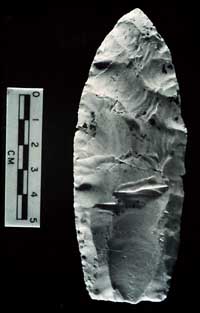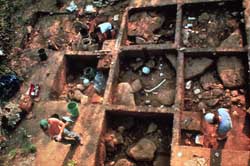
 |
Chert Clovis point from the Lincoln Hills Site, Jersey County, Illinois. |
Lincoln Hills Site
Most Paleoindian sites in Illinois represent small, temporary, and rarely revisited camps, based on the small number of artifacts found at these sites. In contrast, the Lincoln Hills Site, located along the Mississippi River in Jersey County, Illinois, covers a large area and appears to have been visited many times, and, perhaps, occupied for longer periods of time. This location was attractive because stone used to make tools was readily available nearby. The surface of the site is littered with flakes of stone left from making spear points, scrapers, and other tools. Occasionally broken and used tools are found at the site. These were replaced with newly made tools. After a group repaired or replaced their tools, they moved on to another location that provided different resources. When they needed stone for tool making, they would return to Lincoln Hills or another location where stone was available.
 |
|
Aerial view of the museum's excavation at the Kimmswick Site, Jefferson County, Missouri. |
Kimmswick Site
The Kimmswick site is located south of St. Louis, Missouri and is now the site of Mastodon State Park. The Kimmswick Site has long been known as a place where the bones of extinct Ice Age mammals could be found. Albert C. Koch (1804-1867) found mastodon (Mammut americanum) remains at Kimmswick in 1838. In 1979, a team Illinois State Museum paleontologists and archaeologists excavating at Kimmswick found a Paleoindian spear point in contact with a mastodon bone suggesting that people had hunted the animal. They also found another Paleoindian spear point and evidence that the people used the hide of a now-extinct ground sloth (Glossotherium harlani)for a tent or ground cover, suggesting that Paleoindian people had camped at Kimmswick.
|
|
Copyright © 2000 Illinois State Museum